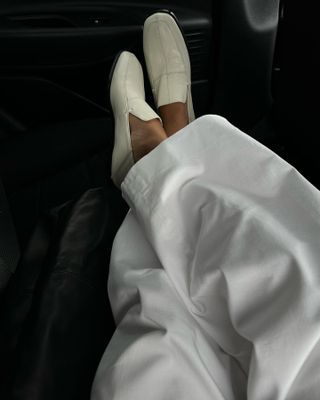
Photography via launchmetrics.com/spotlight
#thrifter currently has over 200 million views on TikTok. But as second-hand shopping comes to a crescendo, Isabel B. Slone argues that good thrift finds are a thing of the past.
By Isabel B. Slone
Date March 23, 2023
I fell out of love with thrifting in the same way that going bankrupt was described in Ernest Hemingway’s The Sun Also Rises: slowly at first, then all at once. In high school, I spent hours sifting through racks of old garments in the musty volunteer-run second-hand store in my hometown of Belleville, Ont. Tucked among the faded scrubs and cast-off Tim Hortons uniforms were gems like 1980s sequined mohair sweaters, creased leather Salvatore Ferragamo pumps and hand-knit Irish-wool cardigans with wooden buttons — each for less than $5.
RELATED: Introducing Canada’s Most Stylish Thrifter, Aldeneil Española
For me, the bounty represented not just an accession of style but an escape from the confines of social class. When I was growing up, my mom sewed most of my wardrobe herself, which at the time marked me as someone unable to afford brand-name labels. But at the thrift store, I could find Lacoste sweaters and vintage Armani suits for less than a pair of jeans at the Gap. All of a sudden, I was dressing better than my classmates. The entire world opened up when I no longer had to choose between quantity and quality. Over countless hours — no doubt at least the 10,000 that Malcolm Gladwell says are required to achieve true expertise — I developed a truffle-pig-like ability to spot treasures, like made-in-England vintage Dr. Martens and Brooks Brothers button-downs. Apparently, all it takes to look expensive is to have a good eye.
While I still love thrifting in theory, in practice, the fluorescent overhead lighting has begun to feel less like a symbol of promise and more like a harbinger of doom. Nowadays, the overwhelming thought I get upon entering a thrift store is “How can I get out of here as soon as possible?” I used to be able to walk into a second-hand shop and stumble across a pair of knee-high made-in-Italy leather combat boots that fit perfectly for $20. Now, all I can find are pilling mall-brand knits and flammable halter tops from Fashion Nova or Shein that fall apart after three wears. After a few minutes of half-heartedly rifling through the crammed racks, I head to the housewares section, do a quick scan for Le Creuset and kitschy figurines and then leave.
This precipitous drop in inventory quality isn’t because more people have caught on to thrifting — though according to a ThredUp study, the second-hand market is projected to experience more growth than any other clothing sector (including fast fashion) between now and 2031 — it’s because clothing brands have engaged in a race to the bottom with regard to garment construction in order to turn a profit. Clothing is one of the rare consumer categories that has actually decreased in price over the past 30 years, even with inflation. When a T-shirt costs less than a carton of eggs, you know there’s a problem. Thrift stores are not just places where unwanted garments move on to their next stage of life; they’re a graveyard where inferior clothing goes to die.
The reality is that thrifting has become such a poignant reminder of the dilemma of consumerism that I would rather avoid it altogether. Instead, I find joy in saving up to thoughtfully acquire new pieces from ethical independent designers.
That said, it isn’t impossible to find good stuff while thrifting; it’s just become much more difficult. If you know what you’re looking for, you’ll still be able to walk away with a few rare gems. Here’s how to spot first-rate finery amid a sea of trash.
Avoid synthetics
Always keep your eyes peeled for items made from natural fibres like wool, cotton, silk and linen. Organic materials are often more breathable than synthetic ones, and they typically have a smaller eco footprint than materials made from petroleum by-products.
Check fabric quality
Designers refer to “the hand” to describe the sensation of a fabric against your skin. For example, how does it feel in your hand? Is the material silky and soft or slippery and staticky? The way a garment feels helps determine how often you will wear it, so be sure you like the fabric just as much as — or even more than — the style before putting it in your cart.
Learn to read labels
A clothing label provides almost as much information as a book — if you know how to read it. It can tell you the age of something, whether it’s high- or low-end and where it was made — all important clues for determining a garment’s quality. Clothing made before 1990 and items made in Italy, England, the United States and Canada tend to be valued for their superior quality (bonus points if the piece is union-made). Notice a designer label? Congratulations! You’ve hit the jackpot.
Assess the workmanship
Examine the garment to see if there are any loose threads; if so, pull them to make sure the piece doesn’t fall apart. Look at the stitching. Is it perfectly straight or wonky? If there’s a pattern, does it line up at the seams? Cheaper-quality garments are usually held together by looping serged hems instead of stitched seams.
Practise patience
Thrifting isn’t like heading to the mall and picking a shirt out of a lineup of acceptable options. Instead, try to have an open mind and allow yourself to be surprised. Keep an idea in your head of what you’re looking for, but don’t get discouraged if you don’t find it immediately. Sometimes it takes years of searching before the Thrift Store Gods deliver on their promise.
This article first appeared in FASHION’s April 2023 issue. Find out more here.

























